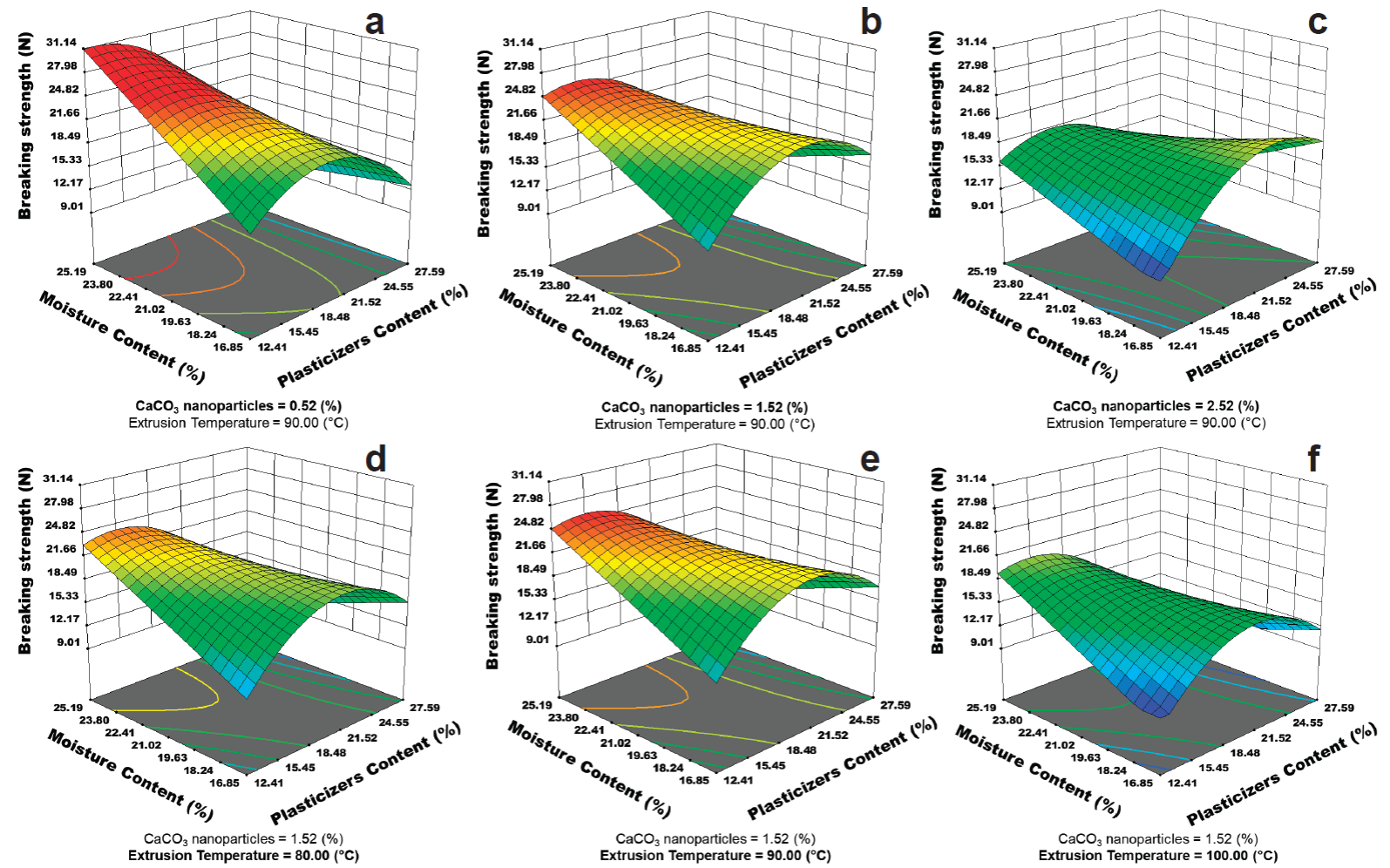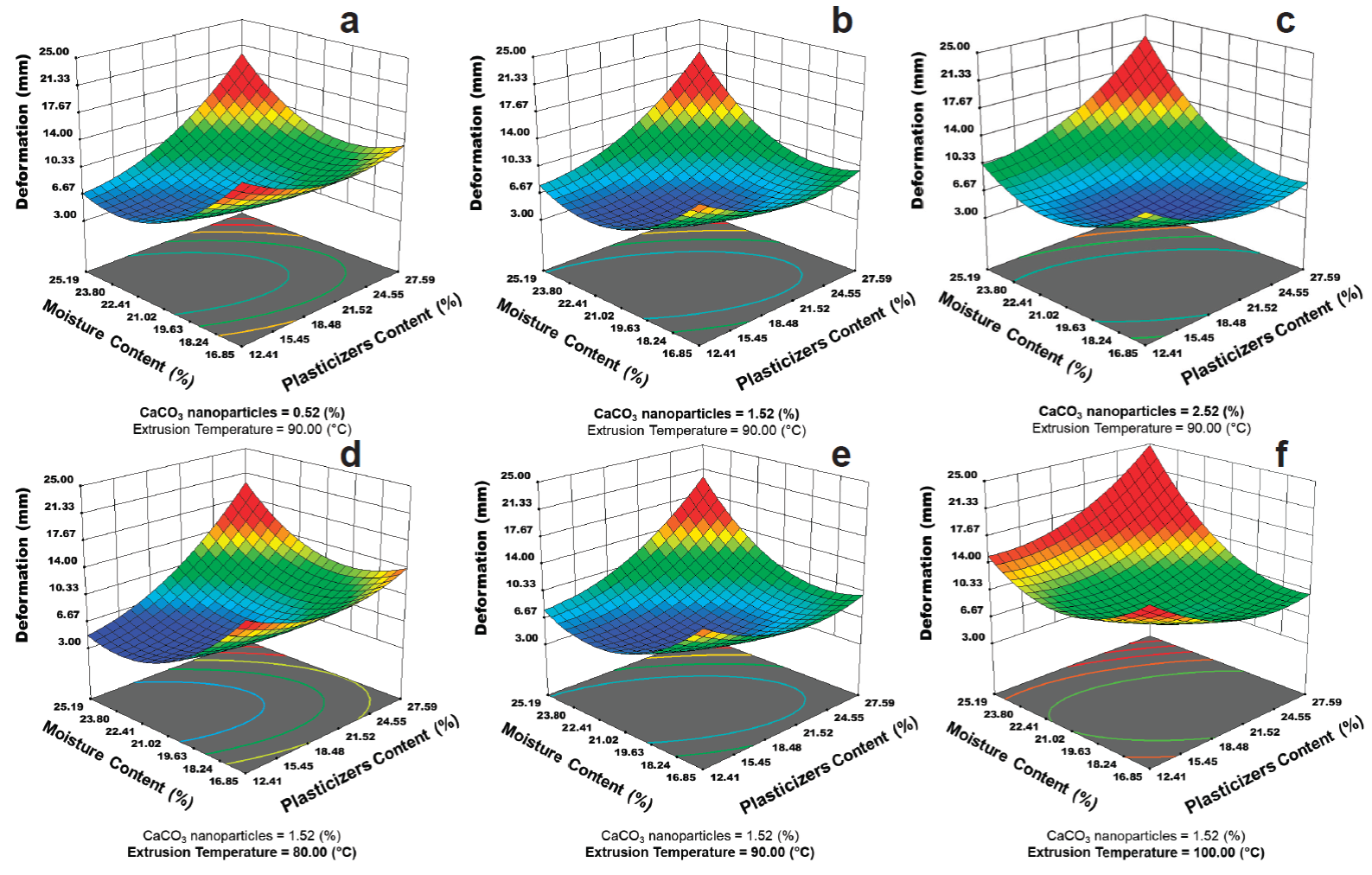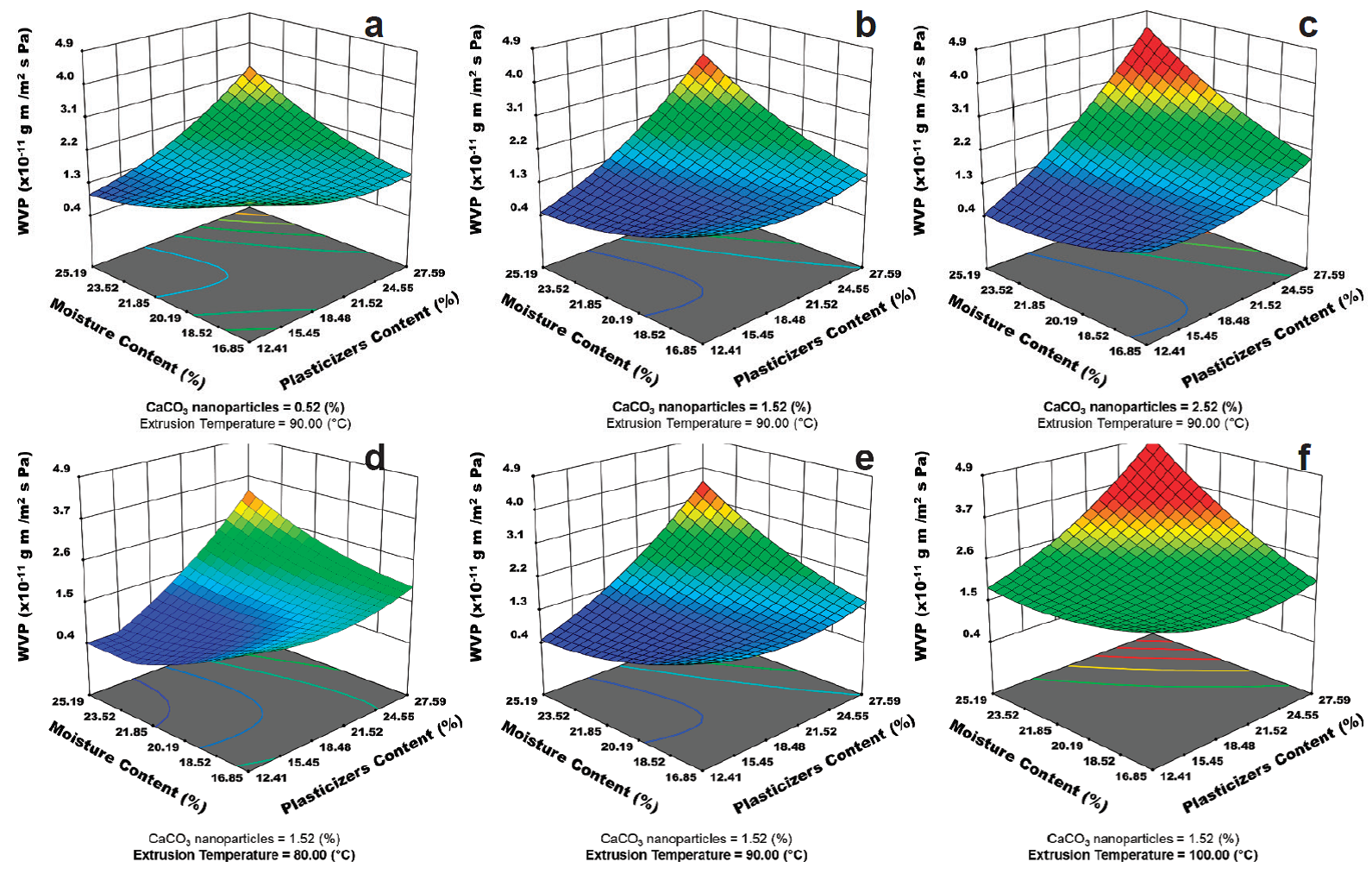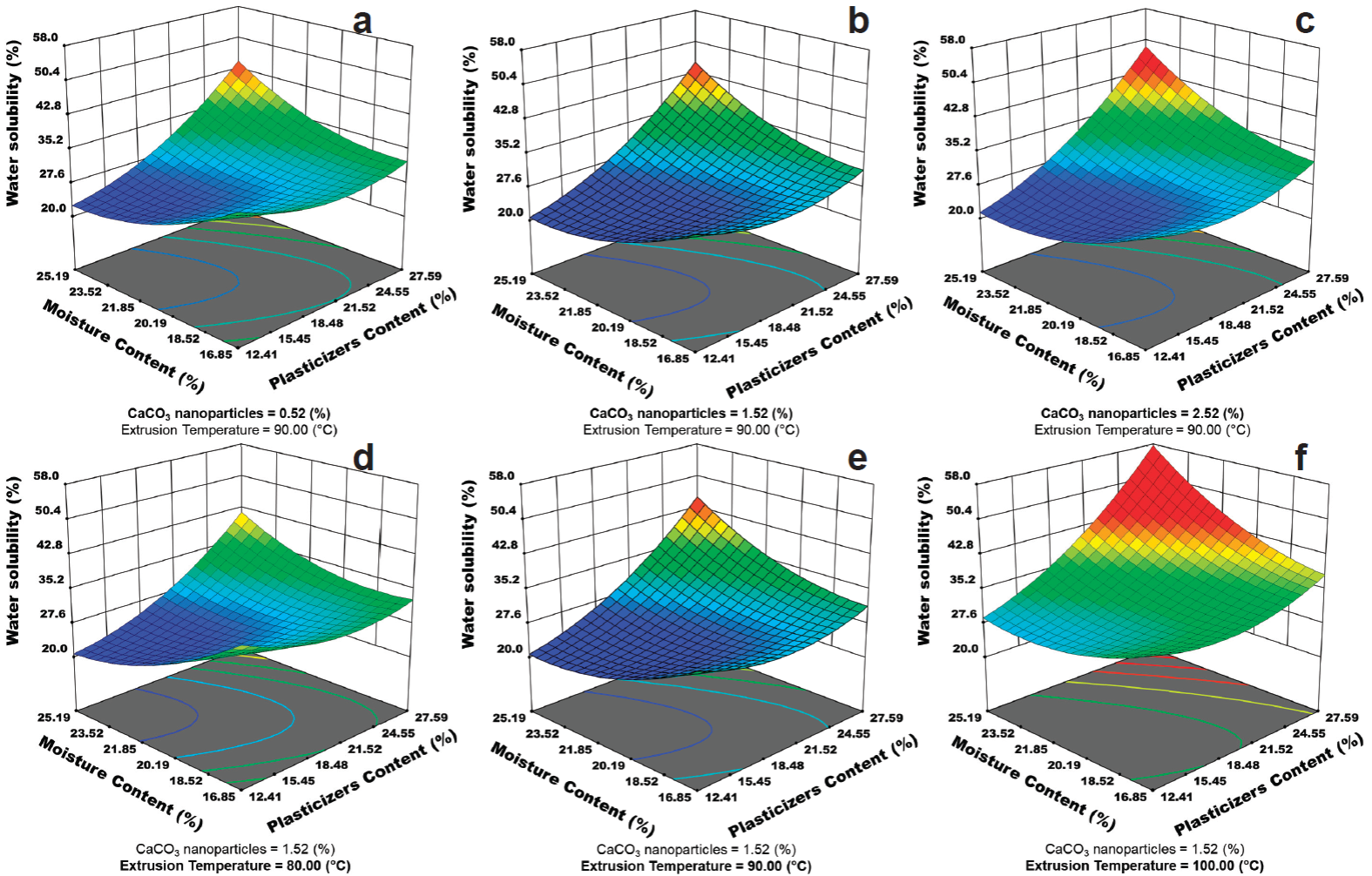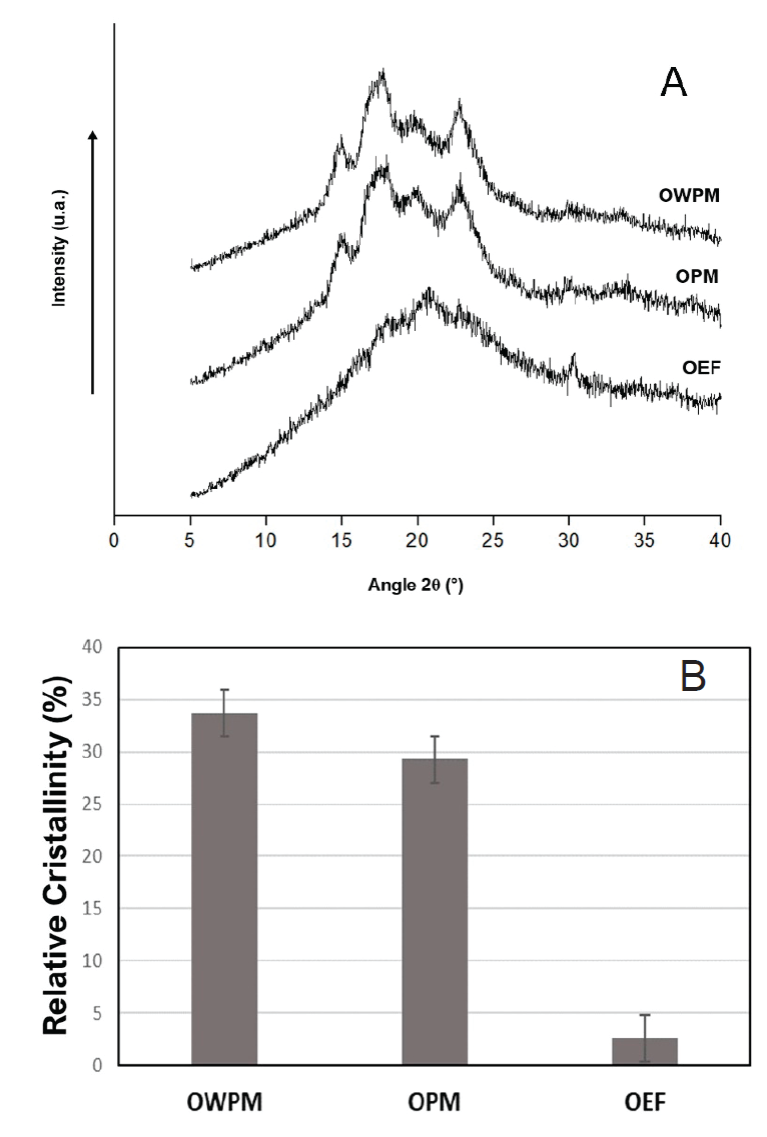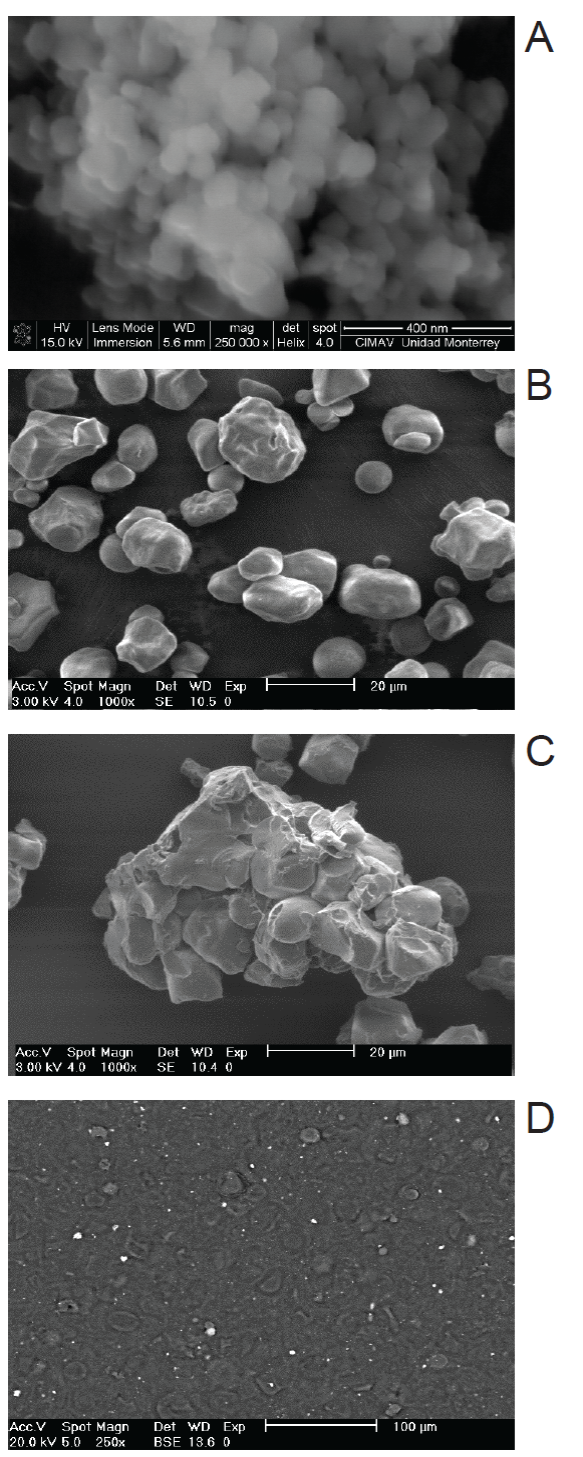Introduction
Starch has been considered one of the biopolymers with the greatest potential to produce biodegradable and edible films by different processing techniques such as casting, injection or blow molding and as well as in combination with others techniques (Teixeira et al., 2012, Chiumarelli y Hubinger, 2014, Li et al., 2015, Calderón-Castro et al., 2018). In this sense, corn starch has many advantages over other starches, and is considered the best of them due to its versatility, high availability, low cost and also, its biodegradability (Aguirre-Joya et al., 2019, Galindez et al., 2019, Kim et al., 2019, Yildirim-Yalcin et al., 2019). Although, it has acceptable physicochemical and good mechanical properties, these could be improved. Calcium carbonate nanoparticles (CCNP) are commonly used since to they add characteristics of greater elongation and resistance in the paper breakage, paint and plastics industry (Hu et al., 2009, Sahebian et al., 2009, Duncan, 2011, Ghadam et al., 2012, ), as well as, improved opacity, whiteness and brightness, and printing properties in quality paper (Buri et al., 2012). Sun et al. (2014) used calcium carbonate nanoparticles with the purpose to improve the mechanical properties, such as flexibility and strength, of films based on corn starch and glycerol by casting. Latest, the use of nanoparticles could be considered for the production of edible starch-based films with characteristics that may improve the post-harvest preservation of fruits (Maftoonazad y Ramaswamy, 2005). Calderón-Castro et al. (2018) evaluated a combined method using extrusion and casting to modify the starch macromolecular matrix (which is exposed to a variety of changes at both levels, intra and intermolecular) and for Edible Films (EF) formation. Thin layers of edible materials can be applied to the preservation, distribution and marketing of post-harvest products (McHugh, 2000, Falguera et al., 2011, Fakhouri et al., 2015, Buso-Ríos et al., 2020). These materials act as barriers, producing modified atmospheres, reducing moisture exchange, controlling microbial growth, and carrying functional ingredients such as antioxidants and antimicrobials (Treviño-Garza et al., 2015). For this reason, the aim of this work was to use calcium carbonate nanoparticles and plasticizers during extrusion (EXT)-casting (CT) combination technologies to obtain EF with improved mechanical and barrier properties.
Materials and methods
Film preparation
Corn starch (Ingredion, Jalisco, Mexico), sorbitol (Cedrosa, Edo. Mexico, Mexico) and glycerol (JT Baker®, Pa., U.S.A.) as well as CCNP (SkySpring Nanomaterials, Inc., TX, USA) were used for EF preparation. The corn starch composition was: 25.58 % amylose and 74.72 % amylopectin. The film preparation was carried out according to Yan et al. (2012) and Fitch‐Vargas et al. (2016) with some modifications. At the first stage, with the use of the extrusion technology, thermoplastic starch was obtained. The mixture was prepared with corn starch and plasticizers, according to the experimental design (Table 1) [sorbitol (80 %) and glycerol (20 %)]. A co-rotating twin screw extruder (Shandong Light M&E, Model LT32L, China) with a L/D of 18.5, screw compression ratio of 2:1, and a circular die with 19 mm of length, 42 mm of diameter and an output of 5 mm was used. The feed rate kept constant at 120 g/min, while moisture content ranged at different ratios according to the experimental design. Barrel temperatures in the feeding (60 °C) and transition (75 °C) zones were constant with respect to the output die temperature (E.g. ET: 90 °C); they varied according to the experimental design by 15 °C between them. The 3 heating zones were independently and electrically heated and water-cooled to maintain the temperature. The thermoplastic starch was collected in water at a 1:4 ratio and stored until use. The product obtained was named extruded formulation. In a second stage, EFs elaborated with the casting technique were obtained. First, CCNP were dissolved in 50 mL of distilled water by ultrasonic mixing (Branson Ultrasonic Cleaner, Danbury, CT, EUA). Briefly, 200 mL of extruded formulation were collected and heated for 10 minutes on a plate (Fisher Scientific, Mass., U.S.A.) at 80 °C; when the temperature reached 30 °C, calcium carbonate nanoparticles were added according to the experimental design. Subsequently, 25 mL of the gelled formulation were poured spilled out into acrylic molds, and then placed into an oven at 60 °C for 2 h ± 0.25 h. The films thickness were measured using a digital micrometer (Digital Insize, Model 3109-25A, Spain), obtaining values of 53 ± 5.22 μm. Finally, films were conditioned at 53 % of relative humidity with a saturated solution of Mg(NO3)2•6H2O (JT Baker®) and they were maintained in a desiccator until analysis.
Tabla 1 Diseño experimental del proceso de extrusión para cuatro factores.
| Trat* | X1 | X2 | X3 | X4 | CaCO3 | ET (°C) | PC (%) | MC (%) | BS | D | WVP | WS |
|---|---|---|---|---|---|---|---|---|---|---|---|---|
| 1 | 0 | 0 | 0 | 1.7317 | 1.52 | 90 | 20 | 25.2 | 13.37 | 11.42 | 1.826E-11 | 29.56 |
| 2 | 0 | 0 | 0 | -0.2692 | 1.52 | 90 | 20 | 19.2 | 22.39 | 05.26 | 1.044E-11 | 25.63 |
| 3 | -1 | -1 | -1 | 0.6045 | 0.52 | 80 | 15 | 21.81 | 18.03 | 07.00 | 1.465E-11 | 29.16 |
| 4 | 1 | -1 | -1 | 0.6045 | 2.52 | 80 | 15 | 21.81 | 12.28 | 13.40 | 3.092E-11 | 43.48 |
| 5 | -1 | 1 | -1 | 0.6045 | 0.52 | 100 | 15 | 21.81 | 25.15 | 06.75 | 1.248E-11 | 25.99 |
| .6 | 1 | 1 | -1 | 0.6045 | 2.52 | 100 | 15 | 21.81 | 15.44 | 14.83 | 2.122E-11 | 36.13 |
| 7 | -1 | -1 | 1 | 0.6045 | 0.52 | 80 | 25 | 21.81 | 12.82 | 5.47 | 9.529E-12 | 25.49 |
| 8 | 1 | -1 | 1 | 0.6045 | 2.52 | 80 | 25 | 21.81 | 26.00 | 4.86 | 8.710E-12 | 24.66 |
| 9 | -1 | 1 | 1 | 0.6045 | 0.52 | 100 | 25 | 21.81 | 7.69 | 12.61 | 3.390E-11 | 41.66 |
| 10 | 1 | 1 | 1 | 0.6045 | 2.52 | 100 | 25 | 21.81 | 13.23 | 13.48 | 1.635E-11 | 31.94 |
| 11 | 1.5177 | 0 | 0 | -1.0498 | 3.03 | 90 | 20 | 16.85 | 18.60 | 14.22 | 2.075E-11 | 32.48 |
| 12 | -1.5177 | 0 | 0 | -1.0498 | 0 | 90 | 20 | 16.85 | 24.62 | 11.29 | 1.685E-11 | 29.25 |
| 13 | 0 | 1.5177 | 0 | -1.0498 | 1.52 | 105.177 | 20 | 16.85 | 20.32 | 5.66 | 1.238E-11 | 25.10 |
| 14 | 0 | -1.5177 | 0 | -1.0498 | 1.52 | 74.823 | 20 | 16.85 | 12.33 | 10.77 | 1.570E-11 | 28.22 |
| 15 | 0 | 0 | 1.5177 | -1.0498 | 1.52 | 90 | 27.59 | 16.85 | 15.65 | 10.41 | 2.654E-11 | 34.85 |
| 16 | 0 | 0 | -1.5177 | -1.0498 | 1.52 | 90 | 12.41 | 16.85 | 18.08 | 11.00 | 2.725E-11 | 32.54 |
| 17 | 0 | 0 | 0 | 0 | 1.52 | 90 | 20 | 20 | 20.99 | 4.91 | 1.129E-11 | 23.97 |
| 18 | 0 | 0 | 0 | 0 | 1.52 | 90 | 20 | 20 | 17.37 | 9.87 | 1.534E-11 | 31.57 |
| 19 | 0 | 0 | 0 | 0 | 1.52 | 90 | 20 | 20 | 21.50 | 5.36 | 1.031E-11 | 25.26 |
| 20 | 0 | 0 | 0 | 0 | 1.52 | 90 | 20 | 20 | 11.13 | 12.66 | 2.572E-11 | 38.73 |
| 21 | 0 | 0 | 0 | 0 | 1.52 | 90 | 20 | 20 | 21.30 | 5.30 | 1.111E-11 | 25.51 |
*The order not corresponding to experimental run
X 1 = CaCO3= Calcium Carbonate Nanoparticles X 2 = ET= Extrusion Temperature, X 3 = PC= Plasticizers Content, X 4 = MC= Moisture Content.
Physicochemical characterization Mechanical properties
Breaking Strength (BS) and Deformation (D) of EF were evaluated with the use of an universal texture analyzer (INSTRON, Model 3342, Mass., U.S.A.) according the ASTM D-5748-95 (ASTM, 1995) methodology, with some modifications and recommendations made by Gontard et al. (1993). BS is the maximum force just before the break, and it is measured in Newtons (N), while D is the breakage distance from the contact with the sample until the break, and it is measured in millimeters (mm). Twenty EF samples from each treatment were used for measuring these mechanical properties.
Water Vapor Permeability (WVP)
The WVP of EF was determined using the gravimetric glass method according to McHugh et al. (1993). Films were placed with 15 g of calcium chloride on the top of glass containers (JT Baker®, Pa., U.S.A.). After that, the containers were placed into a desiccator (Dry Keeper, Sanplatec Corp., Osaka, Japan) with a saturated solution of sodium chloride to generate 75 % of RH. The weight gain of calcium chloride was registered every 12 hours for 4 days by quintuplicate; these data were used to generate a graph of weight gain versus time. WVP was determined according to the next equation:
Where: Mp = moisture absorbed mass (g), E = film thickness (m), A = exposed film area (m2), t = time (s) and Δp = partial pressure difference through the film (Pa).
Water Solubility (WS)
The WS was determined according to the methodology reported by Gontard et al. (1992), as percentage of disintegrated material, as expressed in the following equation:
Where: % WS = water solubility percent, Wi = initial weight of sample and Wf = final weight of sample.
Experimental Design
A hybrid design D416B of the response surface methodology (RSM) with four factors was used (Roquemore, 1976): CaCO3 nanoparticles (CCNP: 0.00 - 3.03 %), extrusión temperature (ET, 74.82 - 105.18 °C), plasticizers content (PC: 12.41 - 27.59 %) and moisture content (MC: 16.85 - 25.19 %). All the independent variable levels were selected according to preliminary experiments and technical limitations of the study at five levels was performed. The whole design consisted of 21 experimental points carried out in random order, which included 16 factorial and axial points, 5 center points, the center of the design was used to allow for estimation of a pure error sum of squares (Table I). A second order polynomial model was used to predict the experimental behavior:
Where: yi = generic response; b 1...44 = regression coefficients; X 1 = CaCO3 nanoparticles, X 2 = Extrusion Temperature and X 3 = Plasticizers Content and X 4 = Moisture Content. The numerical method was applied as optimization technique, where the main criteria for determining the optimal treatment to produce EF were better BS and D (highest values), and WVP and S (lowest values).
Microstructural characterization
To determine the damage caused in starch and plasticizers mixture with and without extrusion process and EF during casting technique, optimal treatment was characterized according to its microstructural properties (X-ray diffraction and Scanning Electron Microscopy).
X-ray diffraction
Samples of optimal treatment, at the various stages of the process were evaluated (without processing mixture -OWPM-, processing mixture -OPM- and edible film -OEF-). This samples were packed into a glass sample holder with a depth of 0.5 mm and mounted on an X-ray diffractometer (Rigaku Model Last D/Max-2100, Rigaku Denki Co. Ltd., Japan). The diffractograms were obtained as described by Gómez et al. (1989) with a sweep angle of Bragg of 4 - 40° over a scale of 2θ with intervals of 0.02, operating at 30 KV and 16 mA, with CuKα radiation and a wavelength λ = 1.5406 Å. Relative crystallinity was calculated using Herman’s method. The percentage of relative crystallinity of the starch was measured by separating the crystalline and amorphous areas in the X-ray diffractograms using an Origin 9.0™ software. The percentage of relative crystallinity was calculated as crystalline area/total area × 100 (Aguilar‐Palazuelos et al., 2006).
Scanning Electron Microscopy (SEM)
Materials obtained were evaluated with SEM analysis, according to the Rodríguez-Castellanos et al. (2015) procedure. Briefly, a powder sample of both, starch and OWPM, were dispersed over the SEM plate and the films were fractured by previously cutting a film piece. Then, they were immersed in liquid nitrogen for 10 seconds, breaked and placed on the copper sample plate holder with 1.2 cm diameter carbon adhesive tape. Samples were placed and covered for 10 min with a light gold layer, then submit for posterior analysis. A SEM (Philips®, Model XL30 ESEM, Eindhoven, Netherlands) was used, employing a secondary electron detector with 15 KV of acceleration. CCNP powder samples were placed on a carboncoated copper grid and characterized in a Scanning Electron Field Emission Microscope (FEI, Nova NanoSEM 200, Shinagawaku, Tokio) with 15 kV acceleration and helix detector in low vacuum conditions.
Data Analysis
Quadratic model for predicting the optimal point was expressed according to the response surface methodology (RSM) The significance of the models was tested using variance analysis (F test). The significances of all terms in the polynomial were judged statistically by computing the F-value at a probability (p≤) of 0.001, 0.01 or 0.05. The regression coefficients were then used to make statistical calculations to generate dimensional and contour maps from the regression models. The response surface regression (RSREG) procedure was determined with Design Expert® Software Version 11.0 (Stat-Ease, Inc., Minn., U.S.A.). The microstructural characterization of the optimal treatment was analyzed by LSD Fisher means comparison (p ≤ 0.05) with StathGraphics Centurion XVIII.
Results and discussion
Physicochemical characterization Breaking Strength (BS)
BS showed a significant model of regression with R2 values of 0.82, coefficient of variation CV = 12.10, and p of F= 0.0005 and showing lack of fit (Table 2). Also, the statistical analysis (Table 3) showed the CCNP and ET in their linear terms (p ≤ 0.05), were the factors that had the most significant effect on the BS. All quadratic terms had a significant effect, except MC. Only CCNP-PC and PC-MC interactions had a significant effect (p ≤0.01).
Tabla 2 Análisis de varianza para las respuestas de RR, D, PVA y SA de películas comestibles de almidón de maíz.
| Response | R2 Adjusted | CV* (%) | F Value | p of F (model) | Lack of fit |
|---|---|---|---|---|---|
| BS | 0.82 | 12.10 | 10.38 | 0.0005 | 0.0141 |
| D | 0.98 | 4.86 | 93.39 | <0.0001 | 0.070 |
| WVP | 0.96 | 7.59 | 43.87 | <0.0001 | 0.064 |
| WS | 0.98 | 2.11 | 112.29 | <0.0001 | 0.487 |
*CV = Coefficient of Variation
BS= Breaking Strength, D= Deformation, WVP= Water Vapor Permeability, WS= Water Solubility.
Table 3 Regression coefficients of the second-order polynomial equations for the BS, D, WVP and WS responses of edible films of corn starch.
Tabla 3 Coeficientes de regresión de las ecuaciones polinomiales de segundo orden para las respuestas de RR, D, PVA y SA de películas comestibles de almidón de maíz.
| BS | D | WVP | WS | ||
|---|---|---|---|---|---|
| Intercept | 22.204 | 5.4752 | 11.348E-12 | 25.191 | |
| Lineal | A | -1.7516** | -0.9815*** | -00.695E-12 | -0.401 |
| B | -1.9046** | 0.9746*** | 04.088E-12*** | 2.800*** | |
| C | -1.1072 | 0.8128*** | 03.718E-12*** | 3.020*** | |
| D | 0.7037 | -0.7593*** | 00.741E-12 | -0.701** | |
| Quadratic | A2 | -1.427* | 0.7574*** | 02.442E-12*** | 1.289*** |
| B2 | -3.610*** | 2.1190*** | 04.947E-12*** | 4.160*** | |
| C2 | -2.735*** | 1.2205*** | 01.635E-12** | 1.695*** | |
| D2 | - | 2.3731*** | 01.399E-12** | 1.756*** | |
| Interactions | A*B | - | - | -02.212E-12** | -1.532*** |
| A*C | 2.0770** | -0.2716 | 02.742E-12*** | 0.870** | |
| A*D | -1.4907 | 1.3304*** | 01.251E-12* | 0.661* | |
| B*C | - | -0.9084*** | -00.589E-12 | 1.264*** | |
| B*D | - | 1.6111*** | 02.482E-12*** | 1.849*** | |
| C*D | -2.3546** | 1.9093*** | 03.861E-12*** | 2.991*** |
*Significant at≤0.05 level.
**Significant at≤0.01 level.
***Significant at≤0.001 level
A= CaCO3= Calcium Carbonate Nanoparticles, B= ET= Extrusion Temperature, C= PC= Plasticizers Content, D= MC= Moisture Content.
BS values ranged from 7.69 to 26 N (Table 1), values higher when compared with those reported by Zhong y Li (2014) (7.82 N), using films elaborated of kudzu starch with glycerol (53 % RH) and employing casting technique only. Figure 1(a-c) show the combined effect of PC, MC and CCNP. The BS increased by the effect of MC, as higher MC and BS. MC produced protective effect (gelatinization delaying), resulting in least damaged structures. However, the presence of plasticizers, which are introduced inside the starch chains, probably, generate more flexible and weak structures with lower BS (Gontard et al., 1993), furthermore, the CCNP presence produce a plasticizing effect, though, there is an interaction with the plasticizers generating an increase on BS values, especially when the CCNP were higher. The effect of the plasticizers, agrees with Arvanitoyannis et al. (1996), who tested different plasticizers in starch-based films, and found that the BS decreased with higher plasticizers. On the other hand, Sun et al. (2014) made corn starch edible films with glycerol adding calcium carbonate nanoparticles. They reported that an increment in calcium carbonate nanoparticles concentration, was directly related to an increment in BS.
Figure 1(d-f) shows the temperature effect over BS. BS increased when temperature was ~90 °C, nevertheless, increment in temperature to ~100 °C, caused a decrease in the BS. These changes in BS may be due to the following: at low temperature could be present some amorphous areas (starch areas without gelatinized), generating less stiffness and causing weak film formation. On the other hand, with intermediate temperatures (~90 °C), structures are opened good enough to have an interaction with the components producing a low resistance; though, high temperatures increase the percent of gelatinized starch, being possible that the structure shows damage resulting in a BS decrease (Bhattacharya y Hanna, 1987). Yan et al. (2012) mentioned that high temperature and strong shear promoted the plasticizing efficiency and can cause the BS decrease.
Deformation (D)
The statistical analysis of the D data for EF showed a significant regression model (R2 = 0.98, CV = 4.86, p of F < 0.0001) and did not show lack-of-fit (p ≥ 0.07) (Table 2). All linear and quadratic terms had a significant effect (p ≤ 0.001) (Table 3), as well as all interactions terms (p ≤ 0.001), with the exception of CCNP-ET and CCNP-PC. The D values in the present study ranged from 4.86 to 14.83 mm (Table 1), values slightly high than those reported by Zhong y Li (2014), who reported a value of 4.11 ± 0.02 mm in kudzu starch edible films. Also, compared with the amilomaize EF values (11.68 mm) of Calderón-Castro et al. (2018), are slightly higher. Figure 2 (a-c) shows PC, MC and CCNP combined effect, in which can be observed that at lowest MC values, a more rigid and less deformable EF were obtained. A low D value could kept structures without damage. On the other hand, the presence of plasticizers induced the formation of more flexible films, generating an increase in D and a decrease in BS. This effect is avoided by adding CCNP, as reported by Sun et al. (2014). Furthermore, high MC and PC values, showed an increment on D. This highest effect may be due to the interaction between the 3 components (MC-PC-CCNP), since, all these variables are having a plasticizing effect under these conditions.
Figure 2(d-f) shows the temperature effect on D. An increase in D was observed, perhaps caused by damaged structures. This damage produced fewer rigid structures and generated greater deformation. However, a low MC and an increased in PC, caused a decrease on D. This effect could be attributed to the increment in PC and temperature, which could generate structures that are physically weaker and therefore less deformable. These results are different than those reported by Calderón-Castro et al. (2018), who found no significant effect of extrusion temperature on deformation.
Water Vapor Permeability (WVP)
The statistical analysis of WVP data for EF showed a significant regression model (RSM) R2 = 0.96, CV = 7.59 and p of F < 0.0001, and did not show lack- of-fit (p ≥ 0.064) (Table 2). The regression coefficients of the model show (Table 3) that only linear terms of CCNP and PC had significant effect (p ≤ 0.001) as well as all quadratic terms (p ≤ 0.001); regarding interactions terms all had significant effect (p ≤0.001), except CCNP-MC (p ≤ 0.01) and ET-PC (no significant). The WVP values in the present study range from 0.87 to 3.39 x 10-11 g m Pa-1 s-1 m-2 (Table 1), which are smaller than those reported by Younis y Zhao (2019), who reported minimum values at 3.3 x 10-10 g m Pa-1 s-1 m-2, in films elaborated with pectin and chitosan by the casting method. Figure 3(a-c) shows the effect of PC, MC and CCNP, on the WVP response. It was mentioned before that, MC has a protective effect during the extrusion process, and it was observed that when MC is increased, it produces structures in the starch matrix which are more integrated and compact, reducing the WVP. Likewise, the presence of CCNP decreases the WVP, which could be due to the CCNP-generated polymer structure, more compact and therefore less permeable, and this is observed especially at low plasticizer content. Moreover, the incorporation of plasticizers, causes the opening of the polymer chains structure generating an increase in the WVP. Dash et al. (2019) evaluated the effect of titanium dioxide (TiO2) nanoparticles (0.5 % - 4 %) on different properties of sweet potato starch and lemon pectin-based EF. They found that WVP diminish with TiO2 nanoparticles increased.
Figure 3(d-f) shows the temperature effect. An increment in temperature produce an increase of WVP. This could be due to a major gelatinization producing molecular disruption of starch chains, increasing the presence of short chains of starch structures, with higher water affinity. These results agrees with Fitch‐Vargas et al. (2016) who reported changes in macromolecular matrix with the temperature and therefore an increase in WVP.
Wang et al. (2019) prepared corn starch bio-active EF packaging based on zein incorporated with orange-peel oil; they found WVP values of 2.15 to 6.62 x 10-11 g m Pa-1 s-1 m-2 (0.122 to 154 mm thickness film), similar to this study, with a difference in film thickness (0.053 ± 0.005 mm). Although permeability is independent of thickness, the permeance is related with the performance of the film when used as packaging materials is dependent of thickness (Buso-Ríos et al., 2020), additionally, in case of EF marketed, less materials for their elaboration will be use.
Water Solubility (WS)
WS showed a significant model of regression (R2 = 0.98, CV = 2.11, and p of F < 0.0001) and did not show lack-of-fit (p ≥ 0.487) (Table 2). The regression coefficients of the model show (Table 3) that all linear terms had significant effect (p ≤ 0.001) except CCNP (no significant), all quadratic terms had significant effect (p ≤ 0.001), as did all interactions terms (p ≤ 0.05). The WS values in the present study range from 23.97 to 43.48 % (Table 1), which are smaller than those reported by Rostami y Esfahani (2019), who made EF with Melissa officinalis seed gum/Montmorillonite (5 %) / curcumin. They mentioned values higher than 45.39 % of WS and they were alike those reported by Mehyar y Han (2004) for rice (32.0 % soluble matter) and pea (44.4 % soluble matter) starches.
Figure 4(a-c) shows the PC, MC and CCNP effect on WS. Higher WS values are related to high MC values, which could be due to the presence of more integral and compact structures, resulting in lower WS values. However, these values show an increase with the PC increment. The incorporation of these plasticizers could be generating structures more susceptible to solubilization, although, the presence of CCNP caused a decrease in solubility at low PC and MC. Similar results were reported by Dash et al. (2019), where they estimated WS between 24.27 to 20.92 % in edible films with TiO2 nanoparticle added.
Figure 4 (d-f) shows the temperature effect on WS. In general, an increase in temperature produces higher solubility values, especially at high PC. This behavior agrees with that reported by Mercier y Feillet (1975) and Calderón-Castro et al. (2018).
Numerical Optimization
The best extrusion conditions were determined using the numerical optimization. The aim was to determine the best conditions of ET, CCNP, PC and MC to obtain EF with the highest BS and D values, as well as lowest WVP and WS values. According to the optimization results, the best process conditions were: CCNP = 0.77 %; ET = 84.23 °C, PC = 21.18 % and MC = 17 %. The following predicted values, corresponding to mathematical models, were obtained: BS = 20.56 N, D = 11.82 mm, WVP = 1.42 x 10-11 g m Pa-1 s-1 m-2 and WS = 29.12 %.
The EF produced with optimal conditions was physi-cochemically characterized, having the following results: BS = 19.40 ± 1.21 N, D = 6.98 ± 0.73 mm, WVP = 1.77 x 10-11 ± 8.6 x10-13 g m Pa-1 s-1 m-2 and WS = 23.44 ± 1.12 %; observing that experimental values to BS and WVP did not showed a significant difference (P < 0.05) regarding to the predicted values with the mathematical models. However, D and WS values were lower than the predicted values of the model used experimentally. The results found in the optimal EF, showed to have a good fit with the model, finding the best conditions of extrusion process and CCNP, ET, PC and MC in the manufacture of EF with good mechanical and barrier properties.
Microstructural Analysis
X-Ray Diffraction
The loss effect of organized crystalline structure by extrusion process and casting technique on X-ray diffraction patterns is shown in Figure 5A. The Optimum Without Processing Mixture (OWPM) and Optimized Processing Mixture (OPM), showed a diffraction pattern type A, which is characteristic of cereals (predominant corn starch in mixture), and both, OWPM and OPM, with two main similar peaks, of ≈ 17.7° and ≈ 22.8° values 2θ, respectively. These results agree with those reported by Koo et al. (2010), who reported values 2θ of ≈ 17.18° and ≈ 22.73°; also Guimarães et al. (2010) reported values 2θ of ≈ 17.7° and ≈ 23.3°, all of them for corn starch. The patterns of OWPM and OPM were similar between them, meaning that the damage in the corn starch was low during the extrusion process. Finally, both OWPM and OPM produced a lightly fragmentation and gelatinization of the starch granules due to the interaction of ET, PC and MC. Oliveira et al. (2017) found changes in diffraction patterns caused by extrusion process from A-type in unprocessed, to V-type in processed materials. Nevertheless, Optimized Edible Film (OEF) showed a V-type pattern with a main peak at 2θ of ≈ 20.7°, appearing an additional small peak at 2θ ≈ 30.4° which can be related to the presence of calcium carbonate nanoparticles as described by Takabait et al. (2016). Zhong y Li (2014) reported that the peak 2θ at ≈20° correspond to the single helical crystal structure of V-type pattern, and it could indicate the formation of amylose - glycerol complexes during processing.
Changes in X ray diffraction patterns affect relative crystallinity in materials processed. Figure 5B shows the relative crystallinity values of the materials studied. OWPM crystallinity was higher than the crystallinity of OPM, showing that extrusion process and plasticizers contributed lightly to starch granules fragmentation, reducing crystalline regions. Figure (5B) also shows that the OEF registered the lowest crystallinity value, which could be due to the casting technique, where starches gelatinization is complete, considerably reducing the crystalline regions. Furthermore, addition of plasticizers contributed to crystallinity decrease. Oliveira et al. (2017) studied the effect of temperature, feed moisture, and whole grain wheat flour on extrusion process severity and degree of starch transformation; they found that during extrusion, loss of crystallinity is caused by mechanical disruption of the molecular bonds within the extruder, due to the intense shear fields. Also, they found relative crystallinities around 25-34 % in raw materials, while processed material was 16-23 %. These results are consistent with those found in the present work.
Scanning Electron Microscopy
Figure 6A shows the CCNP. It is possible to appreciate spherical and semispherical forms with sizes of 26-99 nm. Figure 6B shows the OWPM microstructure. Corn starch granules shows spherical and polygonal shapes and diameters between 5 and 25 µm, similar to those reported by Koo et al. (2010) and Limón-Valenzuela et al. (2017). The image (6B) shows that the main component of the film forming mixture, corn starch, had not changes on its native composition when it was combined with a mixture of plasticizers; nevertheless, it is observed that the starch granules are agglomerated, which could be attributed to the plasticizer’s presence.
Figure 6C shows the extrusion process effect on OPM sample. Starch granules presented an irregular shape, which are semi-open and semimolten; which may be a consequence of the processing effect. Likewise, starch agglomeration was observed indicating that some starch granules were intact after processing. This result provide that the conditions used (ET, PC and MC) in the extrusion process, could be generated by partial breaking of starch granules which allowed its fragmentation and pregelatinizing, maintaining its thermoplastic ability for future application in film formation. Aguilar-Palazuelos et al. (2007) observed that fragmentation of the granular structure and partial plasticization of the material took place during the preparation of corn starch, fiber and glycerol pellets employing the extrusion process; although, the pellets were suitable for its posterior processing by injection molding. Figure 6D shows the OEF. It is possible to observe an irregular surface with the presence of circular and semicircular forms, which are, probably, gelatinized starch granules, which were not destroyed by casting technique, probably it induces the decrement in WS values. Furthermore, it could be appreciated the presence of disperse white flashes with lower intensity, which are the calcium from CCNP embedded on this film, these brilliant points are absent in films without CCNP (data not shown).
Conclusions
Calcium carbonate nanoparticles improved the mechanical and barrier properties of EF, elaborated with extrusion-casting technologies, reinforcing, and plasticizing materials, which were enhanced by the presence of moisture content. The optimal combination allowed us to obtain edible films of corn starch with a mixture of plasticizers with greater BS and D as well as lower WVP and WS values, which could provide light fragmentation, damage and gelatinization of the starch granules, due to the interaction of ET, PC and MC, which were shown with X ray diffraction patterns and relative crystallinity changes in materials OWPM, OPM and OEF. SEM allowed to identify the size and shape of both nanoparticles and processed materials and films.











 nueva página del texto (beta)
nueva página del texto (beta)

